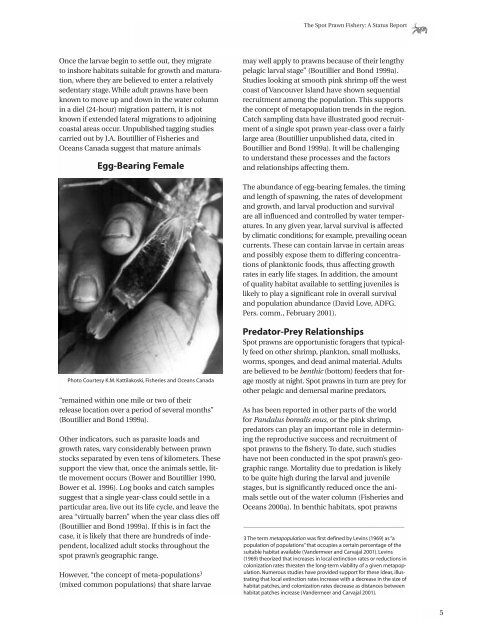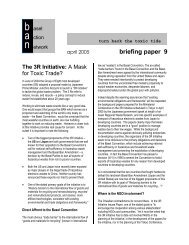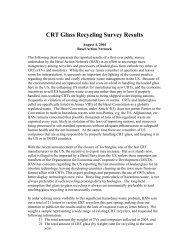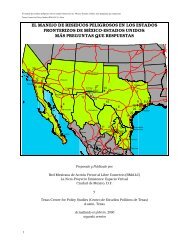The Spot Prawn Fishery The Spot Prawn Fishery - Basel Action ...
The Spot Prawn Fishery The Spot Prawn Fishery - Basel Action ...
The Spot Prawn Fishery The Spot Prawn Fishery - Basel Action ...
Create successful ePaper yourself
Turn your PDF publications into a flip-book with our unique Google optimized e-Paper software.
Once the larvae begin to settle out, they migrate<br />
to inshore habitats suitable for growth and maturation,<br />
where they are believed to enter a relatively<br />
sedentary stage. While adult prawns have been<br />
known to move up and down in the water column<br />
in a diel (24-hour) migration pattern, it is not<br />
known if extended lateral migrations to adjoining<br />
coastal areas occur. Unpublished tagging studies<br />
carried out by J.A. Boutillier of Fisheries and<br />
Oceans Canada suggest that mature animals<br />
Egg-Bearing Female<br />
Photo Courtesy K.M. Kattilakoski, Fisheries and Oceans Canada<br />
“remained within one mile or two of their<br />
release location over a period of several months”<br />
(Boutillier and Bond 1999a).<br />
Other indicators, such as parasite loads and<br />
growth rates, vary considerably between prawn<br />
stocks separated by even tens of kilometers. <strong>The</strong>se<br />
support the view that, once the animals settle, little<br />
movement occurs (Bower and Boutillier 1990,<br />
Bower et al. 1996). Log books and catch samples<br />
suggest that a single year-class could settle in a<br />
particular area, live out its life cycle, and leave the<br />
area “virtually barren” when the year class dies off<br />
(Boutillier and Bond 1999a). If this is in fact the<br />
case, it is likely that there are hundreds of independent,<br />
localized adult stocks throughout the<br />
spot prawn’s geographic range.<br />
However, “the concept of meta-populations 3<br />
(mixed common populations) that share larvae<br />
<strong>The</strong> <strong>Spot</strong> <strong>Prawn</strong> <strong>Fishery</strong>: A Status Report<br />
may well apply to prawns because of their lengthy<br />
pelagic larval stage” (Boutillier and Bond 1999a).<br />
Studies looking at smooth pink shrimp off the west<br />
coast of Vancouver Island have shown sequential<br />
recruitment among the population. This supports<br />
the concept of metapopulation trends in the region.<br />
Catch sampling data have illustrated good recruitment<br />
of a single spot prawn year-class over a fairly<br />
large area (Boutillier unpublished data, cited in<br />
Boutillier and Bond 1999a). It will be challenging<br />
to understand these processes and the factors<br />
and relationships affecting them.<br />
<strong>The</strong> abundance of egg-bearing females, the timing<br />
and length of spawning, the rates of development<br />
and growth, and larval production and survival<br />
are all influenced and controlled by water temperatures.<br />
In any given year, larval survival is affected<br />
by climatic conditions; for example, prevailing ocean<br />
currents. <strong>The</strong>se can contain larvae in certain areas<br />
and possibly expose them to differing concentrations<br />
of planktonic foods, thus affecting growth<br />
rates in early life stages. In addition, the amount<br />
of quality habitat available to settling juveniles is<br />
likely to play a significant role in overall survival<br />
and population abundance (David Love, ADFG.<br />
Pers. comm., February 2001).<br />
Predator-Prey Relationships<br />
<strong>Spot</strong> prawns are opportunistic foragers that typically<br />
feed on other shrimp, plankton, small mollusks,<br />
worms, sponges, and dead animal material. Adults<br />
are believed to be benthic (bottom) feeders that forage<br />
mostly at night. <strong>Spot</strong> prawns in turn are prey for<br />
other pelagic and demersal marine predators.<br />
As has been reported in other parts of the world<br />
for Pandalus borealis eous, or the pink shrimp,<br />
predators can play an important role in determining<br />
the reproductive success and recruitment of<br />
spot prawns to the fishery. To date, such studies<br />
have not been conducted in the spot prawn’s geographic<br />
range. Mortality due to predation is likely<br />
to be quite high during the larval and juvenile<br />
stages, but is significantly reduced once the animals<br />
settle out of the water column (Fisheries and<br />
Oceans 2000a). In benthic habitats, spot prawns<br />
__________________________________________________________<br />
3 <strong>The</strong> term metapopulation was first defined by Levins (1969) as “a<br />
population of populations” that occupies a certain percentage of the<br />
suitable habitat available (Vandermeer and Carvajal 2001). Levins<br />
(1969) theorized that increases in local extinction rates or reductions in<br />
colonization rates threaten the long-term viability of a given metapopulation.<br />
Numerous studies have provided support for these ideas, illustrating<br />
that local extinction rates increase with a decrease in the size of<br />
habitat patches, and colonization rates decrease as distances between<br />
habitat patches increase (Vandermeer and Carvajal 2001).<br />
5















